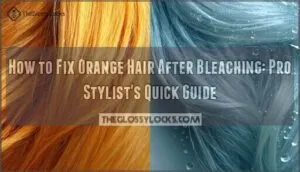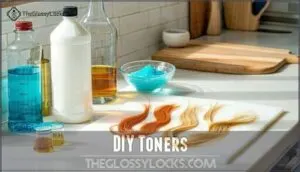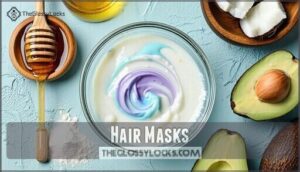This site is supported by our readers. We may earn a commission, at no cost to you, if you purchase through links.

Think of it like color theory – blue cancels out orange on the color wheel. Apply the toner to damp hair, leave it on for 10-20 minutes, then rinse thoroughly.
For milder cases, try a blue shampoo twice weekly. If you’re dealing with stubborn orange patches, you might need another round of gentle bleaching before toning.
Purple shampoo won’t work here since it targets yellow, not orange. The key is patience and using the right color-correcting products. There are specific techniques that work better depending on your hair’s starting shade and condition.
Table Of Contents
- Key Takeaways
- Why Did My Hair Turn Orange?
- Fixing Orange Hair at Home
- Salon Treatments for Orange Hair
- Preventing Orange Hair
- Understanding Orange Hair
- Frequently Asked Questions (FAQs)
- Can you bleach orange hair?
- How do you get orange hair back after bleaching?
- How do you fix orange hair?
- Do dark hair strands turn orange if bleached?
- Why did my hair turn orange after bleaching?
- How to remove orange hair fast?
- How do I get the orange out of my hair after bleaching?
- Should I bleach my hair again if it turned orange?
- How to fix a bad bleach job?
- What toner cancels out orange?
- Conclusion
Key Takeaways
- Use blue-based toner to neutralize orange tones – Apply toner to damp hair for 10-20 minutes, since blue cancels out orange on the color wheel, and purple shampoo will not work for orange hair, since it only targets yellow tones.
- Wait before re-bleaching if toning doesn’t work – Give your hair at least a week to recover between bleaching sessions, and always do a strand test first to avoid severe damage from rushing the process.
- Prevent future orange hair with proper maintenance – Use sulfate-free shampoos, install a shower filter to remove hard water minerals, and protect your hair from sun exposure with UV sprays or hats.
- Consider professional help for stubborn cases – Visit a colorist if at-home fixes are not working, as they have access to stronger toners and can assess whether your hair needs color correction or additional bleaching.
Why Did My Hair Turn Orange?
Your hair turned orange because the bleach didn’t lift enough pigment from your dark hair strands.
When bleach removes color, it reveals the underlying orange and red tones that naturally exist in brown and black hair, especially if you didn’t process it long enough to reach a pale yellow stage, which is crucial for understanding why the bleach didn’t work as expected.
Bleach stops at orange when it doesn’t have enough time to break down your hair’s stubborn red pigments completely.
Dark Hair Turns Brassy
When you’re dealing with bleaching gone wrong, your dark hair’s red undertones are the main culprit behind that unwanted orange mess.
Dark hair has serious pigment saturation and natural darkness that creates bleach resistance, making lift difficulty a real challenge.
Here’s what’s happening beneath the surface:
- Red undertones dominate darker hair and resist lightening
- Dense pigment molecules require more processing time to break down
- Insufficient bleaching stops at orange instead of reaching pale yellow
- Your hair’s thickness affects how deeply bleach can penetrate
This orange brassy hair situation happens because bleach removes pigments in stages.
Dark hair holds onto warm tones stubbornly, so rushing the process leaves you with that telltale orange glow.
Understanding this hair color correction science helps you tackle the problem systematically instead of panicking about your orange hair fix options.
Chemical Buildup
Beyond the obvious culprits of over-bleaching, your hair’s orange transformation might stem from sneaky chemical buildup lurking in your daily routine.
Product ingredients from styling gels, hairsprays, and even your favorite dry shampoo create invisible layers on your hair shaft.
These buildup effects don’t just make your hair feel heavy—they interfere with how light reflects off your strands, amplifying unwanted orange and brassy tones.
A reddish hue can even appear due to hard water minerals.
Here’s how to tackle this orange hair fix challenge:
- Swap regular shampoo for clarifying shampoos weekly to strip away stubborn residue
- Alternate protein and moisture treatments to restore your hair’s natural balance
- Use monthly chelating treatments to remove mineral deposits from hard water
- Follow up with deep conditioning to protect your newly cleansed strands
Your scalp health directly impacts hair color retention.
When buildup clogs follicles, it affects how your hair absorbs and holds pigments.
This bleaching gone wrong scenario becomes a hair color correction nightmare, turning your blonde dreams into orange brassy hair reality.
Pool Water Exposure
Swimming pools frequently turn your freshly bleached hair into an orange disaster. Chlorine oxidation breaks down hair pigments, while copper buildup from pool chemicals creates those unwanted brassy tones. Salt water has similar damaging effects on your delicate color.
Your pool isn’t just stealing your tan—it’s turning your blonde dreams into an orange nightmare with every splash.
Swimmers hair needs extra care because pool chemicals strip protective layers. Chlorine doesn’t just fade your color—it actively changes your hair pigments to orange. Saltwater effects can be equally harsh on bleached strands.
Smart protective measures include rinsing immediately after swimming and using a hair toner weekly to counteract orange buildup.
Fixing Orange Hair at Home
You can fix orange hair at home using several simple methods that work well.
DIY toners, hair masks, and vinegar rinses will help neutralize those unwanted orange tones without visiting a salon.
DIY Toners
When orange tones take over after bleaching, you don’t need expensive salon visits. DIY hair correction starts in your kitchen with simple ingredients that pack serious toner for orange hair power.
Blue food coloring mixed with white conditioner creates an effective blue corrector that neutralizes unwanted brassiness. Start with just two drops per tablespoon of conditioner. For deeper orange issues, try ash blonde dye from drugstore brands – they’re formulated specifically to neutralize orange hair.
ACV rinse balances your hair’s pH while reducing orange tones. Mix one part apple cider vinegar with two parts water, apply after shampooing, and rinse thoroughly. Brunette toners work differently than blonde formulas, so choose based on your target shade.
To explore options, consider browsing products for hair toners. These at-home hair fix solutions require patience and testing. Always do a strand test first, and remember that best toners orange hair responds to work gradually over multiple applications.
Hair Masks
While DIY toners offer quick fixes, hair masks provide deeper correction for stubborn orange tones.
These treatments combine color neutralization with nourishing ingredients that repair bleach damage.
Color-toning masks work differently than regular conditioners.
They deposit blue pigments to neutralize orange hair while delivering protein masks and hydrating masks benefits.
Your hair gets double duty – color correction and damage repair.
DIY masks using kitchen ingredients can be surprisingly effective:
- Honey and Greek yogurt mask – Mix equal parts with one drop of blue food coloring for gentle toning
- Coconut oil and cornstarch blend – Creates a creamy base that conditions while neutralizing brassiness
- Avocado and banana mixture – Packed with nutrients that strengthen hair while subtly cooling warm tones
Apply these mask ingredients weekly, focusing on mid-lengths and ends.
Many people find natural oils moisturize and improve hair health.
Leave on for 15-20 minutes before rinsing.
This DIY hair correction method takes patience but delivers lasting results without harsh chemicals.
Vinegar Rinses
Hair masks work wonders, but apple cider vinegar rinses offer another powerful at-home hair fix.
This natural hair toning method provides impressive ACV benefits for orange hair and brassy hair alike.
The application method is simple: mix ingredients and saturate hair completely.
This hair lightening technique also tackles buildup removal from previous treatments.
Use this rinse frequency of once weekly for best results without over-drying your strands.
Salon Treatments for Orange Hair
When you’re at-home attempts haven’t fixed your orange hair, it’s time to visit a professional colorist who can assess your hair’s condition and choose the right treatment.
Salon experts have access to stronger toners, professional-grade bleaches, and color correction techniques that can safely transform your orange hair into your desired shade.
Bleaching
Professional bleaching requires the right technique to lift stubborn orange tones effectively.
Your stylist will evaluate several factors before proceeding:
- Strand Tests determine how your hair responds to bleach quality formulations
- Developer Volume selection (20-30 vol) based on your hair’s current condition
- Bleach Lifting Power assessment using professional-grade products like Brilliant Blondexx
- Application Technique guarantees even coverage while protecting previously processed areas
This systematic approach transforms brassy hair into the perfect canvas for toning treatments.
Understanding bleach product options is essential for ideal results.
Toning
Salon-grade toning transforms your brassy nightmare into blonde brilliance. Professional colorists select the perfect toner based on your hair’s current level and desired outcome.
Many find that using blue-based toners effectively neutralizes orange tones.
| Hair Color Level | Toner Selection | Application Techniques |
|---|---|---|
| Orange (Level 6-7) | Blue-based toners | 20-minute processing time |
| Yellow-orange (Level 8) | Purple toners | Even sectioning required |
| Light yellow (Level 9) | Ash toners | Root-to-tip application |
Your stylist applies toner maintenance products for lasting results against orange hair returning.
Color Correction
When basic toners fall short, professional color correction becomes your rescue plan.
Colorists use advanced Toner Selection and Professional Glazes to tackle stubborn orange hair and brassy hair issues.
Here’s their game plan:
- Blue Correctors neutralize orange tones effectively
- Ash Blonde formulas create cooler results
- Dyeing Darker covers orange completely when needed
They’ll assess your hair’s condition first, then apply targeted color correction techniques.
Some situations call for blue shampoo maintenance, while others need complete shade transformation.
Professional expertise guarantees you get salon-quality results.
Preventing Orange Hair
You can avoid orange hair by choosing the right products and protecting your hair from things that cause color changes.
The key is using sulfate-free shampoos, limiting sun exposure, and washing with filtered water to keep your blonde looking fresh.
Avoid Sun Exposure
Summer’s blazing rays act like invisible bleach, turning your carefully lightened locks into unwanted orange territory.
UV damage breaks down hair’s protective proteins, accelerating color fading and creating those dreaded brassy tones you worked so hard to avoid.
Smart protection starts with the right arsenal.
Hair sunscreens containing zinc oxide shield your strands from harmful rays, while wide-brimmed hats create instant shade coverage.
A balanced diet can also support hair health.
Apply protective products before heading outdoors, just like you’d protect your skin.
These sunscreens for hair prevent UV rays from oxidizing your color molecules.
Hat protection offers foolproof coverage during peak sun hours.
Your future self will thank you when your hair color stays vibrant instead of shifting orange.
Use Sulfate-Free Products
After protecting your hair from sun damage, your next move is choosing the right products to keep orange hair at bay.
Sulfate-free products are your best friend when maintaining bleached hair. Regular shampoos contain harsh sulfates that strip away color and natural oils, making your hair more prone to brassiness.
Here’s how sulfate alternatives protect your hair:
- Gentle cleansing preserves your hair’s natural moisture barrier
- Color retention lasts longer without harsh detergents washing away toner
- Scalp health improves with milder product ingredients
- Hair hydration stays balanced, preventing dryness and breakage
- Orange hair prevention becomes easier with pH-balanced formulas
Look for shampoos with coconut-derived cleansers or natural surfactants. Finding the right sulfate-free shampoo products can be a game changer.
Blue shampoo works great for orange-toned hair, while purple shampoo handles yellow brassiness. Pair these with a quality hair toner for maximum color protection.
Filtered Water
Hard water minerals turn your bleaching dreams into orange hair nightmares.
Calcium and iron deposits cling to damaged cuticles, making brassy hair worse over time.
Installing a shower filter protects color longevity while supporting scalp health.
Different filter types target specific contaminants—carbon removes chlorine, while KDF filters tackle heavy metals.
Water purity directly impacts mineral retention in your strands.
A quality filtered water system prevents buildup that dulls your perfect blonde and keeps your hair toner working effectively.
Understanding Orange Hair
When you bleach your hair and it turns orange, it means the bleach didn’t lift enough of the dark pigments from your hair shaft.
Your hair is stuck at level 6 instead of reaching the pale yellow stage at level 9 or 10, which leaves those stubborn orange tones behind, resulting from the incomplete removal of dark pigments, specifically the dark pigments.
Importance of Toners
Toners act like your hair’s personal color therapist, neutralizing those stubborn orange tones that bleaching leaves behind. Think of toner selection as choosing the right tool for the job—blue-based formulas tackle orange hair while violet handles yellow brassiness.
Professional toners deliver stronger results than drugstore options, but proper toner application matters more than brand names. You’ll want to:
- Apply toner to damp, towel-dried hair for even coverage
- Leave on for 10-20 minutes, checking every 5 minutes
- Use gloves to prevent staining your hands
- Rinse with cool water to seal the cuticle
- Follow with deep conditioner for hair health
Maintaining coolness requires regular toning sessions every 4-6 weeks. Hair color correction isn’t a one-time fix—it’s an ongoing relationship between you and your toner.
Transitioning Hair Colors
When dealing with orange hair after bleaching, progressing to your desired shade requires patience and strategy. Professional consultation becomes your best friend during this journey, especially for drastic transformations that could damage your hair further.
Smart color correction starts with understanding your hair’s current condition. Gradual color change works better than rushing the process, giving your strands time to recover between treatments.
Here’s your roadmap for safe color transitions:
- Wait at least two weeks between bleaching sessions to prevent severe damage
- Use a color remover before applying new dye to eliminate stubborn orange tones
- Apply blue-based toner to neutralize brassy undertones effectively
- Choose demi-permanent hair dye for gentler color shifts that fade naturally
- Deep condition weekly to support maintaining hair health throughout the process
Remember, orange hair indicates your bleaching process wasn’t complete. Rather than repeatedly bleaching, consider professional color correction services. They’ll assess your hair’s integrity and create a custom plan that gets you to your dream shade safely.
Causes of Yellow Hair
Three main culprits turn your hair bleaching dreams into a yellow hair nightmare.
First, inconsistent bleaching leaves behind stubborn pigment undertones that weren’t fully lifted. Your hair porosity affects how evenly bleach penetrates, creating patchy results.
Second, product buildup from styling products and hard water minerals creates a barrier that traps yellow hair tones. These minerals stick to your strands like magnets.
Third, environmental factors like sun exposure and chlorine break down toner molecules faster than warm pigments. Blue color fades quickly, leaving orange hair undertones exposed.
Understanding these causes helps you choose the right hair dye correction method and prevent future color disasters.
Frequently Asked Questions (FAQs)
Can you bleach orange hair?
Surprisingly, you can bleach orange hair again, but wait at least a week first.
Your hair needs recovery time between sessions.
Check if it’s healthy enough before re-bleaching to avoid serious damage.
How do you get orange hair back after bleaching?
You can’t directly "get" orange hair back after bleaching, but you can achieve warm tones by using golden or copper hair dye.
Applying honey-toned toners, or visiting a colorist for professional warm-toned treatments, are also viable options.
How do you fix orange hair?
Like a traffic cone screaming for attention, orange hair demands immediate action.
You’ll need blue-based toner to neutralize those brassy tones, or re-bleach after waiting two weeks if your hair’s healthy enough.
Do dark hair strands turn orange if bleached?
Yes, dark hair strands commonly turn orange when you bleach them.
Dark hair contains more underlying orange and red pigments that become visible once you strip away the darker surface colors during bleaching.
Why did my hair turn orange after bleaching?
While you expected blonde perfection, your hair stayed stubbornly orange because you didn’t bleach long enough.
Dark hair contains red pigments that turn orange when partially lifted, requiring more processing time to reach pale yellow before toning.
How to remove orange hair fast?
You’ll need to apply a blue-based toner immediately to neutralize orange tones. Mix toner with 20-volume developer, leave for 15-20 minutes, then rinse. Purple shampoo maintains results between treatments.
How do I get the orange out of my hair after bleaching?
Use a blue or purple toner to neutralize orange tones immediately.
If that’s not enough, re-bleach after two weeks when your hair’s recovered.
Always do a strand test first to avoid further damage.
Should I bleach my hair again if it turned orange?
Wait at least a week before re-bleaching to avoid severe damage.
Check if your hair feels healthy first.
If it’s brittle or breaking, try toning with blue-based products instead of more bleach.
How to fix a bad bleach job?
That "professional" salon visit didn’t go as planned? Don’t panic.
You’ve got three solid options: tone it with blue-based products, re-bleach carefully after waiting, or dye darker to cover the disaster completely.
What toner cancels out orange?
Blue toner neutralizes orange hair effectively since blue sits opposite orange on the color wheel.
You’ll want to choose a blue-based toner or ash blonde shade to cancel out those unwanted warm tones completely.
Conclusion
Like Goldilocks finding the perfect porridge, learning how to fix orange hair after bleaching requires finding the right balance.
You’ve got the tools now – blue-based toners for immediate correction, maintenance shampoos for ongoing care, and prevention strategies to avoid future mishaps.
Remember, patience beats panic every time, and it’s crucial to trust the process. Your hair didn’t turn orange overnight, and it won’t return to your dream shade instantly either.
Follow these steps consistently, and you’ll achieve beautiful and brass-free results.











